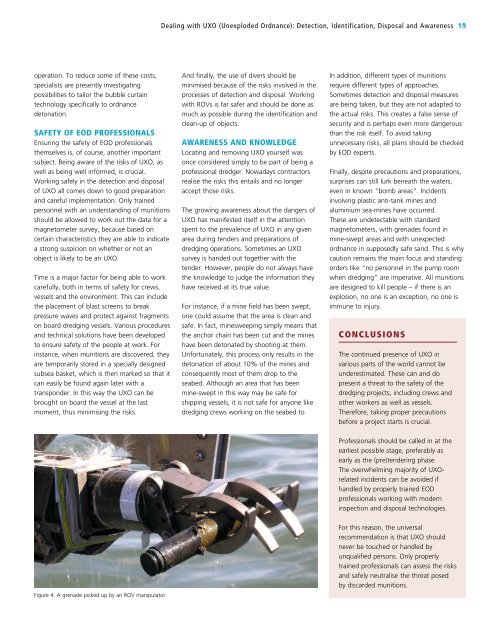You also want an ePaper? Increase the reach of your titles
YUMPU automatically turns print PDFs into web optimized ePapers that Google loves.
Dealing with UXO (Unexploded Ordnance): Detection, Identification, Disposal and Awareness 19<br />
operation. To reduce some of these costs,<br />
specialists are presently investigating<br />
possibilities to tailor the bubble curtain<br />
technology specifically to ordnance<br />
detonation.<br />
SAFETY OF EOD PROFESSIONALS<br />
Ensuring the safety of EOD professionals<br />
themselves is, of course, another important<br />
subject. Being aware of the risks of UXO, as<br />
well as being well informed, is crucial.<br />
Working safely in the detection and disposal<br />
of UXO all comes down to good preparation<br />
and careful implementation. Only trained<br />
personnel with an understanding of munitions<br />
should be allowed to work out the data for a<br />
magnetometer survey, because based on<br />
certain characteristics they are able to indicate<br />
a strong suspicion on whether or not an<br />
object is likely to be an UXO.<br />
Time is a major factor for being able to work<br />
carefully, both in terms of safety for crews,<br />
vessels and the environment. This can include<br />
the placement of blast screens to break<br />
pressure waves and protect against fragments<br />
on board dredging vessels. Various procedures<br />
and technical solutions have been developed<br />
to ensure safety of the people at work. For<br />
instance, when munitions are discovered, they<br />
are temporarily stored in a specially designed<br />
subsea basket, which is then marked so that it<br />
can easily be found again later with a<br />
transponder. In this way the UXO can be<br />
brought on board the vessel at the last<br />
moment, thus minimising the risks.<br />
And finally, the use of divers should be<br />
minimised because of the risks involved in the<br />
processes of detection and disposal. Working<br />
with ROVs is far safer and should be done as<br />
much as possible during the identification and<br />
clean-up of objects.<br />
AWARENESS AND KNOWLEDGE<br />
Locating and removing UXO yourself was<br />
once considered simply to be part of being a<br />
professional dredger. Nowadays contractors<br />
realise the risks this entails and no longer<br />
accept those risks.<br />
The growing awareness about the dangers of<br />
UXO has manifested itself in the attention<br />
spent to the prevalence of UXO in any given<br />
area during tenders and preparations of<br />
dredging operations. Sometimes an UXO<br />
survey is handed out together with the<br />
tender. However, people do not always have<br />
the knowledge to judge the information they<br />
have received at its true value.<br />
For instance, if a mine field has been swept,<br />
one could assume that the area is clean and<br />
safe. In fact, minesweeping simply means that<br />
the anchor chain has been cut and the mines<br />
have been detonated by shooting at them.<br />
Unfortunately, this process only results in the<br />
detonation of about 10% of the mines and<br />
consequently most of them drop to the<br />
seabed. Although an area that has been<br />
mine-swept in this way may be safe for<br />
shipping vessels, it is not safe for anyone like<br />
dredging crews working on the seabed to<br />
In addition, different types of munitions<br />
require different types of approaches.<br />
Sometimes detection and disposal measures<br />
are being taken, but they are not adapted to<br />
the actual risks. This creates a false sense of<br />
security and is perhaps even more dangerous<br />
than the risk itself. To avoid taking<br />
unnecessary risks, all plans should be checked<br />
by EOD experts.<br />
Finally, despite precautions and preparations,<br />
surprises can still lurk beneath the waters,<br />
even in known “bomb areas”. Incidents<br />
involving plastic anti-tank mines and<br />
aluminium sea-mines have occurred.<br />
These are undetectable with standard<br />
magnetometers, with grenades found in<br />
mine-swept areas and with unexpected<br />
ordnance in supposedly safe sand. This is why<br />
caution remains the main focus and standing<br />
orders like “no personnel in the pump room<br />
when dredging” are imperative. All munitions<br />
are designed to kill people – if there is an<br />
explosion, no one is an exception, no one is<br />
immune to injury.<br />
CONCLUSIONS<br />
The continued presence of UXO in<br />
various parts of the world cannot be<br />
underestimated. These can and do<br />
present a threat to the safety of the<br />
dredging projects, including crews and<br />
other workers as well as vessels.<br />
Therefore, taking proper precautions<br />
before a project starts is crucial.<br />
Professionals should be called in at the<br />
earliest possible stage, preferably as<br />
early as the (pre)tendering phase.<br />
The overwhelming majority of UXOrelated<br />
incidents can be avoided if<br />
handled by properly trained EOD<br />
professionals working with modern<br />
inspection and disposal technologies.<br />
Figure 4. A grenade picked up by an ROV manipulator.<br />
For this reason, the universal<br />
recommendation is that UXO should<br />
never be touched or handled by<br />
unqualified persons. Only properly<br />
trained professionals can assess the risks<br />
and safely neutralise the threat posed<br />
by discarded munitions.


